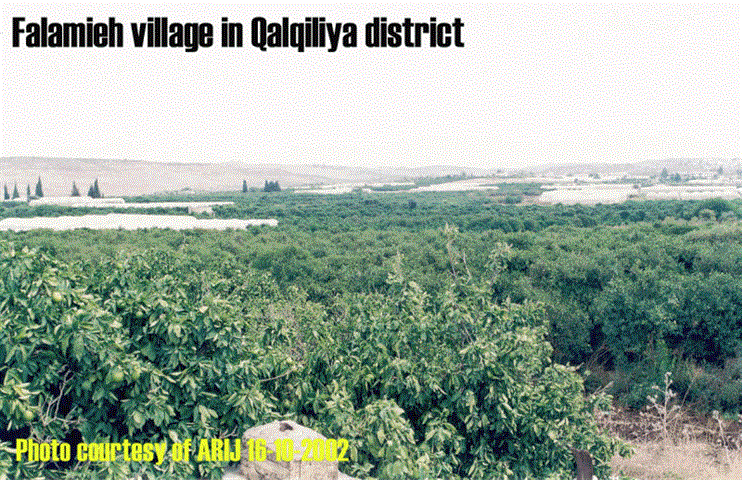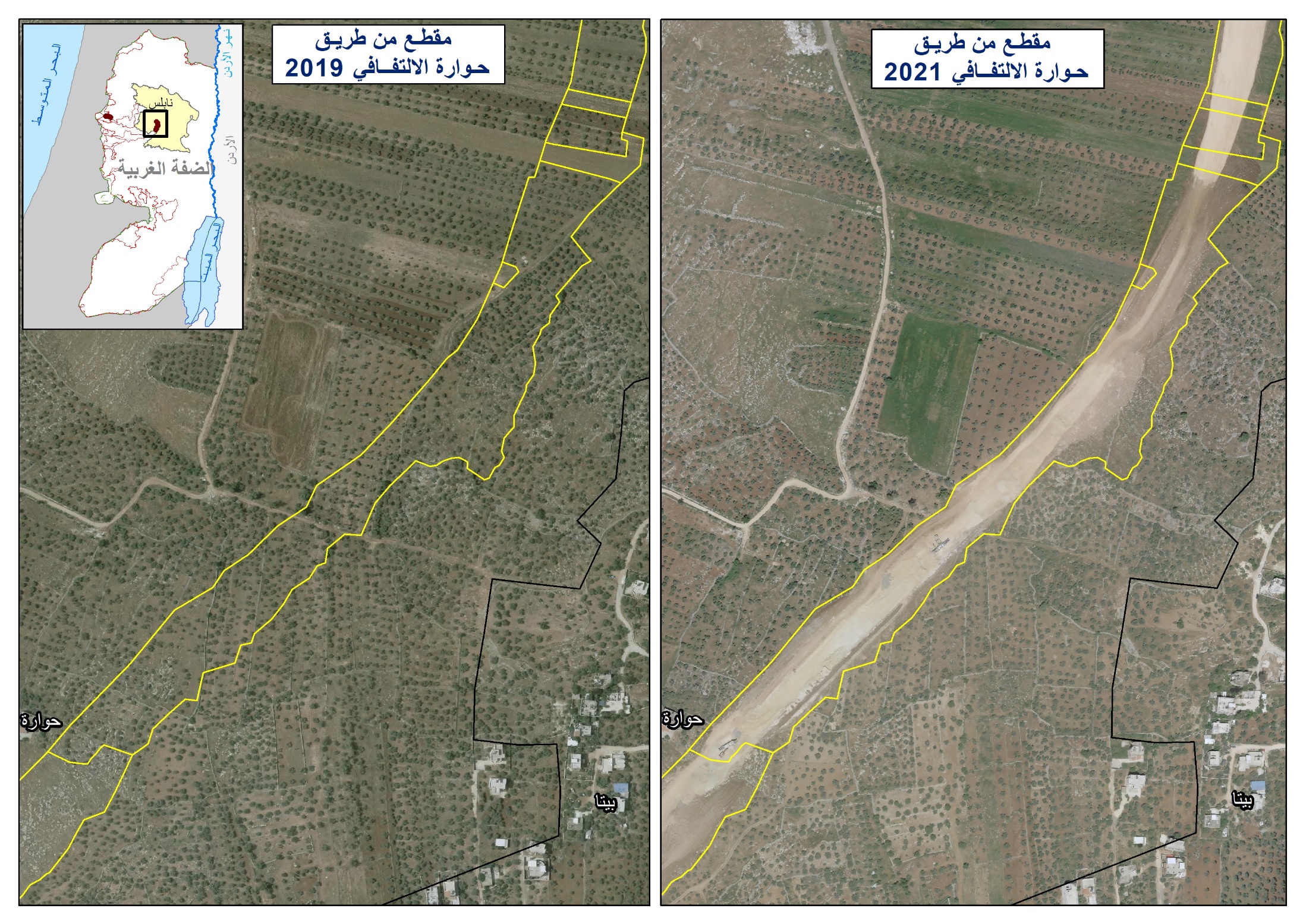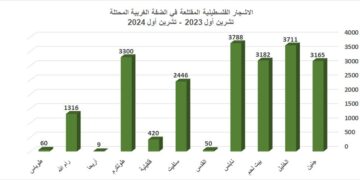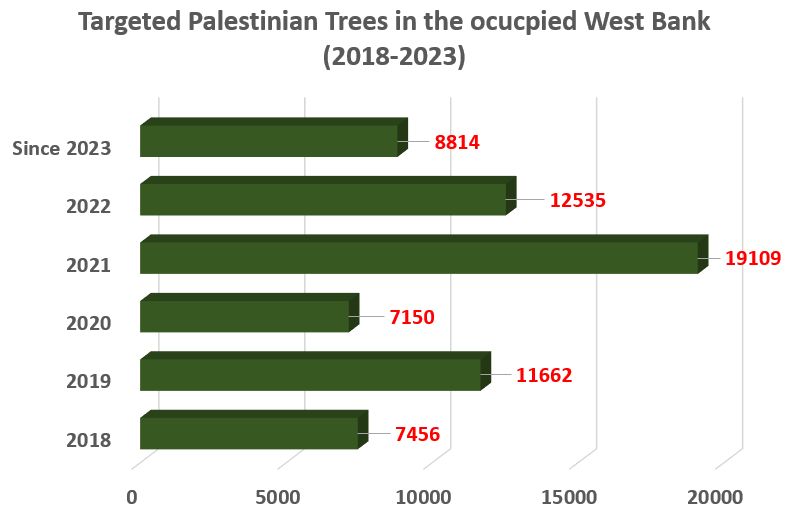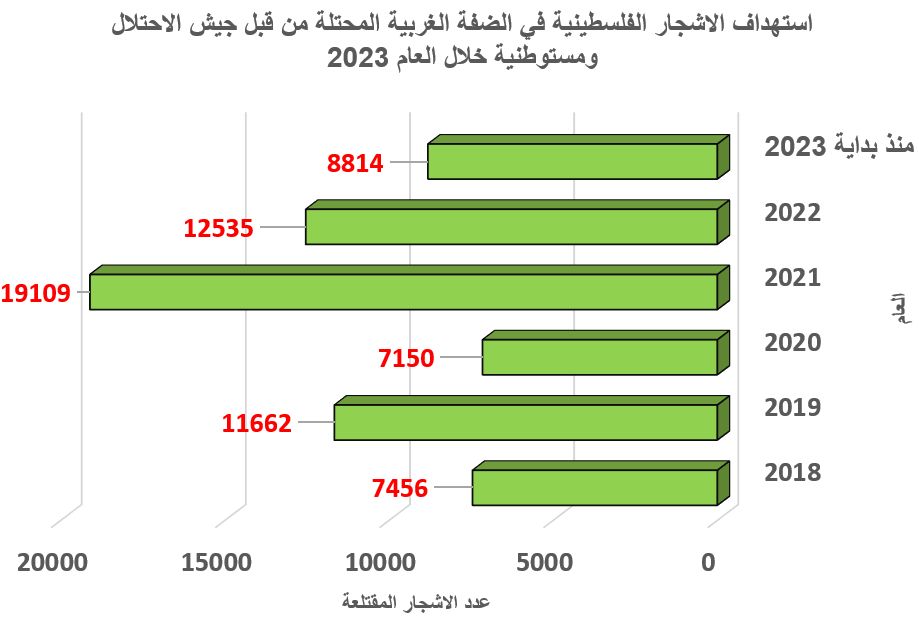Restrictive measures imposed by the Israeli occupation authority against the Palestinian economy and especially during the period 29/9/2000 – 31/1/2003 created numerous obstacles, which have further complicated and aggravated an already precarious situation. Agriculture is a major contributor to the Palestinian gross domestic product and employs a high percentage of the Palestinian work force.
Marketing of farm products to the Palestinian, Israeli or world markets is one of many Israeli obstacles faced by the Palestinian farmers. The closure and complete seal of the cities hindered the capability of marketing the agriculture products. Other potential working activities such as transportation were hindered by the Israeli closure of the Palestinian towns and villages. This in addition to the loss of revenue as a result of Israeli uprooting of 748815 trees.
The following is a list of some of Israeli practices that have affected the agricultural sector:
- The policy of closure and separation between villages and districts.
- Uprooting, bulldozing and burning trees.
- Harassing farmers while working on the land and preventing them from picking their produce.
- Limiting the movement of herds.
- Destroying agricultural lands and uprooting trees in order to construct military locations at the entrances of Palestinian districts and villages.
- Destroying green houses.
- Constructing the Israeli segregation wall
- Closing the fishing harbor and limiting the movements of the fishermen.
These practices have led to the following results:
-
Hindering marketing process and reducing prices of agricultural products.
-
Stopping an agricultural projects that aimed to enhance the infrastructure and the production efficiency of the sector.
-
Limiting the provision of agricultural inputs and an increase in their prices.
-
Paralyzing the movement of agricultural laborers.
-
Restricting the transport of agricultural products, the Israeli lorries only being allowed to transfer goods to the entrances of districts.
-
The difficulty in providing the agricultural services has led to a fall in production and the spread of various diseases in both plant and animal production.
The Ministry of Agriculture (MOA) has formed emergency committees in all districts in order to continue to provide the MOA services under closure. These committees have worked with institutions on the national level in order to evaluate the losses. This report summarized the various damages exposed to the Palestinian agricultural sector during the period between 29/9/2000 and 31/1/2003.
Table 1, shows the damages caused by the Israeli aggression on the Palestinian agricultural sector, including the destruction of agricultural wells and other agricultural constructions during the period of 29/9/2000 – 31/1/2003.
Table 2: Damages caused by the Israeli aggression on the Palestinian agricultural sector, during the period of 29/9/2000 – 31/1/2003
|
Type of losses |
Number of losses |
|
Demolition of agricultural stores |
248 |
|
Demolition of poultry farms |
122 |
|
Demolition of animal enclosures |
56 |
|
Killing sheep and goats |
3633 head |
|
Killing cattle and farm animals |
595 head |
|
Damaging bee hives |
6261 hive |
|
Wells destruction |
212 |
|
Demolition of farmer houses |
207 |
|
Poultry death |
1411789 bird |
|
Bulldozing irrigation networks |
11581 dunums |
|
Destruction of agricultural ponds and reservoirs |
778 |
|
Bulldozing farms walls and fences |
157424 meters |
|
Destruction of main lines of water pipes |
330572 meters |
|
Number of affected farmers |
8117 farmers |
|
Bulldozing agricultural area planted with field crops |
8349 dunums |
|
Bulldozing agricultural area planted with fruit trees |
24531 dunums |
|
Destroying agricultural area planted with vegetables under green houses |
865 dunums |
|
Bulldozing agricultural area planted with vegetables in open field |
20342 dunums |
|
Total area bulldozed |
54087 |
|
Destroying packaging and grading stations |
1 |
|
Bulldozing agricultural experiment stations |
2 |
|
Bulldozing agricultural nurseries |
3 |
Table 2, shows numbers of uprooted trees by the Israelis during the period of 29/9/2000 – 31/1/2003
Table 2: Numbers of uprooted trees during the period 29/9/2000 – 31/1/2003
|
Type |
Olive |
Citrus |
Stone Fruits |
Forest |
Dates |
Bananas |
Vine |
Others |
Total |
|
No. |
213175 |
207909 |
59941 |
112934 |
18822 |
18400 |
48627 |
69007 |
748815 |
The following is a summary highlights the Palestinian losses in the agricultural sector as a result of Israeli aggression and closure of the Palestinian cities and communities.
-
Loss from stopping the exports to Israeli and world markets: Sub total of losses = $ 29,500,000
-
Reduction of agricultural and livestock product prices in local markets
The closure policy prohibited the farmers from reaching their marketing areas within the local markets. As a result, the farmers sold their products at the site of production with lower prices. The losses as a result of that can estimated as: Sub total of losses =US $ 134,980,000
- Uprooting trees, bulldozing crops, and destructing of green houses and farming equipments: Sub total of losses = US $ 188,319,026
- Reduction of revenues from agricultural transportation, marketing and exporting: Sub total of losses = US $ 52,460,000
- Loss in livestock production
As a result of the continue closure, the price of animal feed increased and farmers reduced the amount of food required to animals and birds, which led to loss in the weights of animals, chickens and egg production.
Sub total of losses = US $ 49,026,500
-
Fishing
As a result of closing Gaza harbor and preventing the fishermen to get out to the Palestinian water: Sub total of losses = US $ 6,063,660
Olive sector
The deterioration of security conditions and the dangers farmers were exposed led to difficulties for the farmers in accessing their lands to pick olives.In addition, there were tens of tons of olive fruits stolen and confiscated: Sub total of losses = US $ 15,504,237
Agricultural workers
The proportion of agricultural workers in Palestine reaches to 13% of the total working force. For example, there are 10,000 workers from southern districts working in picking and packaging of agricultural products in the northern districts. These contract labors could not reach their working areas because of the Israeli closure. If we added the losses of working days from other agricultural workers in other parts of Palestine, the actual losses in productivity can reach to: Subtotal of contract farm workers losses = US $ 291,380,000
Losses because of bulldozing 54087dunums of land which was planted with various types of crops: Sub total of losses =US $ 43,269,600
-
X. Losses in agricultural production due to inaccessibility to conduct various agricultural activities such as replanting of bulldozed areas with trees and field crops: Sub total of losses = US $ 66,948,277
Thus, the total direct losses since the beginning of Al-Aqsa Intifada in September 29, 2000 up to January 31, 2003 as a result of Israeli aggression on the Palestinian agricultural sector is $ 877,451,300
Source: Ministry of Agriculture. The Palestinian agricultural losses due to Israeli aggressions (September 29, 2000 – January 31, 2003). Ramallah, Palestine.
Prepared by:
The Applied Research Institute – Jerusalem


